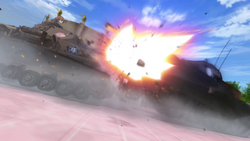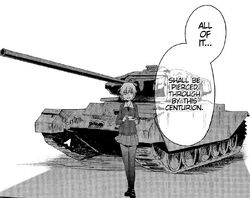| Spoiler warning! This Wiki contains detailed information regarding the Girls und Panzer universe. Proceed with Caution! |
- "The Centurion drove past us!"
- ―Azusa
The Centurion, introduced in 1945, was a British main battle tank of the post-Second World War period. It is widely considered to be one of the most successful post-war tank designs, remaining in production into the 1960s and seeing combat in the front lines into the 1980s. The chassis was also adapted for several other roles and these have remained in service to this day. It first appeared in Girls und Panzer der Film.
Background
History
The development of the tank began in 1943 and manufacture of the Centurion began in January 1945, six prototypes arrived Belgium less than a month after the war in Europe ended in May 1945. It first entered combat with the British Army in the Korean War in 1950, in support of the Union Nations forces. The Centurion later served in the Indo-Pakistani War of 1965, where it fought against US-supplied M47 and M48 Patton tanks and it served with the Royal Australian Armoured Corps in Vietnam.
Israel used Centurions in the 1967 Six Day War, 1973 Yom Kippur War, and during the 1978 and 1982 invasions of Lebanon. Centurions modified as armoured personnel carriers were used in Gaza, the West Bank and on the Lebanese border. The Royal Jordanian Land Force used Centurions, first in 1970 to fend off a Syrian incursion within its borders during the Black September events and later in the Golan Heights in 1973. South Africa deployed its Centurions in Angola during the South African Border War.
It became one of the most widely used tank designs, equipping armies around the world, with some still in service until the 1990s. As recently as the 2006 Israel-Lebanon conflict the Israel Defense Forces employed heavily modified Centurions as armoured personnel carriers and combat engineering vehicles. The South African National Defense Force still employs over 200 Centurions, which were modernized in the 1980s and 2000s as the Olifant.
Between 1946 and 1962, 4,423 Centurions were produced, consisting of 13 basic marks and numerous variants. In British Army its was replaced by the Chieftain in 1966.
Development
In 1943, the Directorate of Tank Design, under Sir Claude Gibb, Fellow of the Royal Society and the Commander of Most Excellent Order of the British Empire was asked to produce a new design for a heavy cruiser tank under the General Staff designation A41. After a series of fairly mediocre designs in the A series in the past, and bearing in mind the threat posed by the German 88 mm gun, the War Office demanded a major revision of the design requirements, specifically: increased durability and reliability, the ability to withstand a direct hit from the German 88 mm gun and providing greater protection against mines. Initially in September 1943 the A41 tank was to weigh no more than 40 tons; the limit for existing Mark I and Mark II transport trailers, and for a Bailey Bridge of 80 ft (24m) span. The British railway loading gauge required that the width should not exceed 10 ft 8 in (3.2m) and the optimum width was 10 ft 3 in (3.1m). A high top speed was not important, while agility was to be equal to that of the Comet. A high reverse speed was specified, as during the fighting in southern Italy, Allied tanks were trapped in narrow sunken roads by the German Army. The modified production gearbox had a two-speed reverse, with the higher reverse speed similar to second gear.
The department produced a larger hull by adapting the long-travel five-wheel Christie suspension used on the Comet with the addition of a sixth wheel, and extending the spacing between the second and third wheels. The Christie suspension, with vertical spring coils between side armour plates, was replaced by a Horstmann suspension with three horizontally sprung, externally mounted two-wheel bogies on each side. The Horstmann design did not offer the same ride quality as the Christie system, but took up less room and was easier to maintain. In case of damage by mines, individual suspension and wheel units could be replaced relatively easily. The hull was redesigned with welded, sloped armour and featured a partially cast turret with the highly regarded 17 pounder (76.2 mm/3 inch) as the main gun and a 20 mm Polsten cannon in an independent mounting to its left. With a Rover-built Rolls-Royce Meteor engine, as used on the Comet and Cromwell, the new design would have excellent performance.
But even before the Outline Specification of the A41 was released in October 1943, these limits were removed and the weight was increased from 40 to 45 tons, because of the need for heavier armour and a wider turret (too wide for the tank to be transported by rail) with a more powerful gun. The new version carried armour equal to the heaviest infantry tanks, while improved suspension and engines provided cross-country performance superior to even the early cruiser tanks. The War Office decided it would be wiser to build new trailers, rather than hamper what appeared to be a superb design. Historian David Fletcher states, "But was Centurion, after all, a Universal Tank? The answer has to be a qualified negative."
The design mock-up built by AEC Ltd was viewed in May 1944. Subsequently, 20 pilot models were ordered with various armament combinations: ten with a 17-pdr and a 20 mm Polsten gun (of which half had a Besa machine gun in the turret rear and half an escape door), five with a 17-pdr, a forward Besa and an escape door, and five with a QF 77 mm gun and a driver-operated hull machine gun.
Prototypes of the original 40-ton design, the Centurion Mark I, had 76 mm of armour in the front glacis, which was thinner than that on the then current infantry tanks (the Churchill), which had 101 mm. However, the glacis plate was highly sloped, and so the effective thickness of the armour was very high—a design feature shared by other effective designs, such as the German Panther tank and Soviet T-34. The turret was well armoured at 152 mm. The tank was also highly mobile, and easily outperformed the Comet in most tests. The up-armoured Centurion Mark II soon arrived; it had a new 118 mm-thick glacis and the side and rear armour had been increased from 38 mm to 51 mm. Only a handful of Mk I Centurions had been produced when the Mk II replaced it on the production lines. Full production began in November 1945 with an order for 800 on production lines at Leyland Motors, Lancashire the Royal Ordnance Factories at Leeds and Woolwich, and Vickers at Elswick. The tank entered service in December 1946 with the 5th Royal Tank Regiment
In Girls und Panzer
Der Film
A single Centurion MkI appeared in the movie under the property of Selection University and having Alice Shimada as the commander. It appeared during the annihilation match between Selection University and the Ooarai Compound Team, having only actively participated in the final stages of the battle.
During the initial stages, the Centurion stayed behind the front line until both sides reached the Amusement Park, the Centurion then stayed idle on high ground, with Alice observing and coordinating her company commanders, the Bermuda Trio.
After both sides had suffered considerable losses, the Centurion advanced to the front line with Alice singing the Boko song to signalize her entrance for her teammates, disabling with 100% of accuracy all enemy tanks it met on its way to rendezvous with her company commanders and the enemy commanders to set the match.
The tanks it disabled are: Chi-Ha-Tan's 2x Type 97 Chi-Ha, Type 97 ShinHoto Chi-Ha, Type 95 Ha-Go, Type 89B (Duck Team), M3 Lee (Rabbit Team), Hetzer (Turtle Team), Type 3 Chi-Nu (Anteater Team), Anzio's CV-33 and Char B1 Bis (Mallard Team).
After cleaning its path, it reached the center of the Amusement, with Megumi and Azumi's M26 Pershing against Miho's Panzer IV and Maho's Tiger I. Initially, the Panzer and Tiger avoided directly facing the Centurion to disable the supporting Pershings, coming up with creative teamed up ambushes. After taking them down, leaving the Centurion against the Panzer and Tiger I, that battle resumed itself in exchange of fires, with near misses, side shoots and the destruction of that area of the Amusement Park, mostly due to Centurion's HE shells. At some point during this exchange of fires, Miho's Panzer ended with its rear on the aim of the Centurion at point-blank range, however an automated Boko passed between the two tanks, making Alice hold her fire and giving time to Miho to run away. Alice probably hold her fire due to her being a huge fan of Boko than due to distraction. However, Miho took a few seconds to retreat, having a close near miss, demonstrating a distraction. After this, the Panzer and Tiger planned a last move, going to the top of the cave and having the Tiger firing a blank shell on the Panzer's rear to provide impulse and advancing into the Centurion at high speed, limiting their reaction time. Doing this the Panzer IV managed to stay at point-blank range in the Centurion and fired disabling both tanks, as the Panzer lost its treads.
Trivia
- This tank is currently the latest World War II Tank in the series.
- Originally in the Monthly Comic Alive magazine version Kilimanjaro landed in Bellwall Academy's ground with a Centurion tank but during the match she uses a Black Prince, it has been corrected in the paper version as the Centurion has been replaced by the Black Prince.
Gallery
References
http://www.army-technology.com/projects/olifant/
[https://en.wikipedia.org/wiki/Centurion_(tank)
| Tanks ☰ | ||
|---|---|---|
| Light Tanks and Tankettes | ||
| Medium Tanks | ||
| Heavy Tanks | ||
| Tank Destroyers | ||
| Self-Propelled Artillery | ||
| Main Battle Tank | ||
https://en.wikipedia.org/wiki/Centurion_(tank)TanksLightTanksandTankettesPanzerkampfwagenII•Panzer38(t)•Crusader•M24Chaffee•M22Locust•T-70•Type95Ha-Go•Type97Te-Ke•BT-42•AMR-35•R35•FT-17•CVL3/33•7TP•TKTankette
MediumTanksPanzerkampfwagenIII•PanzerkampfwagenIV•PanzerkampfwagenV"Panther"•MatildaII•CenturionMarkI•M3Lee•M4Sherman•T-34•T-44•Type89I-Go/Chi-Ro•Type3Chi-Nu•Type97Chi-Ha•SomuaS35•CarroArmatoP40•M13/40HeavyTanksPanzerkampfwagenVI"Tiger"•PanzerkampfwagenVIAusf.B"TigerII"•VK45.01PorscheTiger•PanzerkampfwagenVIII"Maus"•ChurchillMarkVII•BlackPrince•IS-2•KV-2•M26Pershing•RenaultB1Bis•CarroArmatoP40 TankDestroyersSturmgeschützIII•Jagdpanzer38(t)"Hetzer"•JagdpanzerIV•Jagdpanther•Elefant•Jagdtiger•T28SuperHeavyTank•Semoventeda75/18 Self-PropelledArtilleryKarl-GerätMortar MainBattleTankType10]












